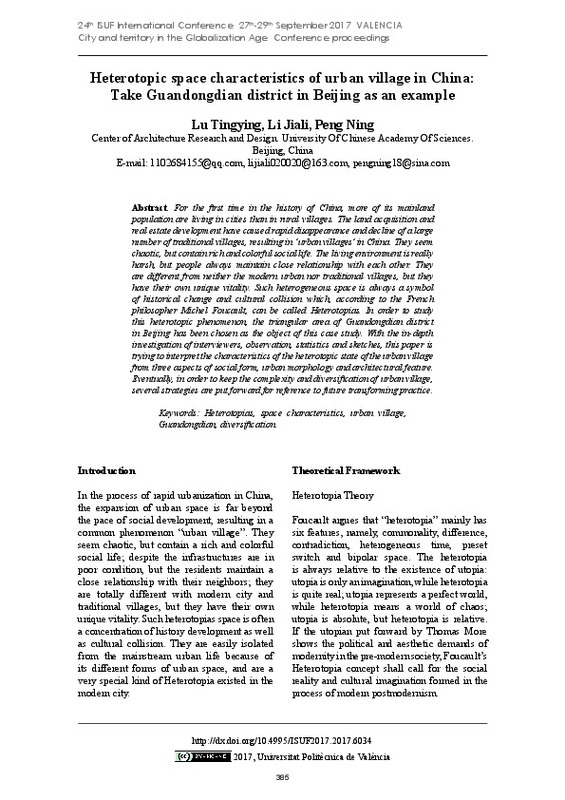JavaScript is disabled for your browser. Some features of this site may not work without it.
Buscar en RiuNet
Listar
Mi cuenta
Estadísticas
Ayuda RiuNet
Admin. UPV
Heterotopic space characteristics of urban village in China: Take Guandongdian district in Beijing as an example
Mostrar el registro sencillo del ítem
Ficheros en el ítem
| dc.contributor.author | Lu, Tingying
|
es_ES |
| dc.contributor.author | LI, Jiali
|
es_ES |
| dc.contributor.author | Peng, Ning
|
es_ES |
| dc.coverage.spatial | east=116.45646510000006; north=39.9228212; name=21 Guan Dong Dian Bei Jie, Chaoyang Qu, Beijing Shi, Xina, 100001 | es_ES |
| dc.date.accessioned | 2018-12-17T07:59:52Z | |
| dc.date.available | 2018-12-17T07:59:52Z | |
| dc.date.issued | 2018-04-20 | |
| dc.identifier.isbn | 9788490485743 | |
| dc.identifier.uri | http://hdl.handle.net/10251/113878 | |
| dc.description.abstract | [EN] For the first time in the history of China, more of its mainland population are living in cities than in rural villages. The land acquisition and real estate development have caused rapid disappearance and decline of a large number of traditional villages, resulting in "urban villages" in China. They seem chaotic, but contain rich and colorful social life. The living environment is really harsh, but people always maintain close relationship with each other. They are different from neither the modern urban nor traditional villages, but they have their own unique vitality. Such heterogeneous space is always a symbol of historical change and cultural collision which, according to the French philosopher Michel Foucault, can be called Heterotopias. In order to study this heterotopic phenomenon, the triangular area of Guandongdian district in Beijing has been chosen as the object of this case study. With the in-depth investigation of interviews, observation, statistics and sketches, this paper is trying to interpret the characteristics of the heterotopic state of the urban village from three aspects of social form, urban morphology and architectural feature. Eventually, in order to keep the complexity and diversification of urban village, several strategies are put forward for reference to future transforming practice. | es_ES |
| dc.format.extent | 10 | es_ES |
| dc.language | Inglés | es_ES |
| dc.publisher | Editorial Universitat Politècnica de València | es_ES |
| dc.relation.ispartof | 24th ISUF International Conference. Book of Papers | es_ES |
| dc.rights | Reconocimiento - No comercial - Sin obra derivada (by-nc-nd) | es_ES |
| dc.subject | Heterotopias | es_ES |
| dc.subject | Space characteristics | es_ES |
| dc.subject | Urban village | es_ES |
| dc.subject | Guandongdian | es_ES |
| dc.subject | Diversification | es_ES |
| dc.title | Heterotopic space characteristics of urban village in China: Take Guandongdian district in Beijing as an example | es_ES |
| dc.type | Capítulo de libro | es_ES |
| dc.type | Comunicación en congreso | es_ES |
| dc.identifier.doi | 10.4995/ISUF2017.2017.6034 | |
| dc.rights.accessRights | Abierto | es_ES |
| dc.description.bibliographicCitation | Lu, T.; Li, J.; Peng, N. (2018). Heterotopic space characteristics of urban village in China: Take Guandongdian district in Beijing as an example. En 24th ISUF International Conference. Book of Papers. Editorial Universitat Politècnica de València. 385-394. https://doi.org/10.4995/ISUF2017.2017.6034 | es_ES |
| dc.description.accrualMethod | OCS | es_ES |
| dc.relation.conferencename | 24th ISUF 2017 - City and Territory in the Globalization Age | es_ES |
| dc.relation.conferencedate | Septiembre 27-29,2017 | es_ES |
| dc.relation.conferenceplace | Valencia, Spain | es_ES |
| dc.relation.publisherversion | http://ocs.editorial.upv.es/index.php/ISUF/ISUF2017/paper/view/6034 | es_ES |
| dc.description.upvformatpinicio | 385 | es_ES |
| dc.description.upvformatpfin | 394 | es_ES |
| dc.type.version | info:eu-repo/semantics/publishedVersion | es_ES |
| dc.relation.pasarela | OCS\6034 | es_ES |








